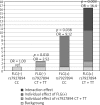Chromosome 11q13.5 variant as a risk factor for atopic dermatitis in children
- PMID: 32467693
- PMCID: PMC7247065
- DOI: 10.5114/ada.2020.93388
Chromosome 11q13.5 variant as a risk factor for atopic dermatitis in children
Abstract
Introduction: Atopic dermatitis is a chronic inflammatory skin disease with a strong genetic basis. Recent GWASs have identified a single nucleotide polymorphism on chromosome 11q13.5 (rs7927894) as novel susceptibility loci of atopic dermatitis.
Aim: To evaluate the association of this genetic variant with atopic dermatitis and to investigate its possible interaction with filaggrin null mutations in children population.
Material and methods: One hundred eighty-eight children less than 2 years old were screened for the variant of allele of rs7927894 on chromosome 11q13.5 and for the 4 most prevalent filaggrin mutations. The variant of allele of rs7927894 and all filaggrin mutations were genotyped by real-time PCR assays with subsequent melting curve analysis using SimpleProbe® probes.
Results: The allele of rs7927894[T] was associated with a significantly increased risk of atopic dermatitis (OR = 2.21; 95% CI: 1.14-4.28; p = 0.015). Both allergic and non-allergic patient groups had rs7927894[T] allele significantly more frequently than the control group, however, the frequency of alleles did not differ in these two groups. Interestingly, when rs7927894 variant and filaggrin mutations were considered together, the risk of atopic dermatitis was the most increased in the subjects who combined both rs7927894[T] allele and filaggrin mutations (OR = 16.41; p = 0.003).
Conclusions: Our results indicate that the rs7927894 variant on chromosome 11q13.5 may play a role in the development of atopic dermatitis, but this effect seems to be independent of allergic sensitization and of the well-established filaggrin risk alleles, but may be modulated by gene-gene interactions.
Keywords: chromosome 11q13.5; eczema; filaggrin; genetic association.
Copyright: © 2020 Termedia Sp. z o. o.
Conflict of interest statement
The authors declare no conflict of interest.
Figures
References
-
- Schultz Larsen F, Hanifin J. Epidemiology of atopic dermatitis. Immunol Allergy Clin North Am. 2002;22:1–24.
-
- Williams H, Robertson C, Stewart A, et al. Worldwide variations in the prevalence of symptoms of atopic eczema in the international study of asthma and allergies in childhood. J Allergy Clin Immunol. 1999;103:125–38. - PubMed
-
- Taylor B, Wadsworth J, Wadsworth M, et al. Changes in the reported prevalence of childhood eczema since the 1939-45 war. Lancet. 1984;2:1255–7. - PubMed
-
- Kay J, Gawkrodger DJ, Mortimer MJ, et al. The prevalence of childhood atopic eczema in a general population. J Am Acad Dermatol. 1994;30:35–9. - PubMed
-
- Brown SJ, McLean SWH. Eczema genetics: current state of knowledge and future goals. J Invest Dermatol. 2009;129:543–52. - PubMed
LinkOut - more resources
Full Text Sources

